





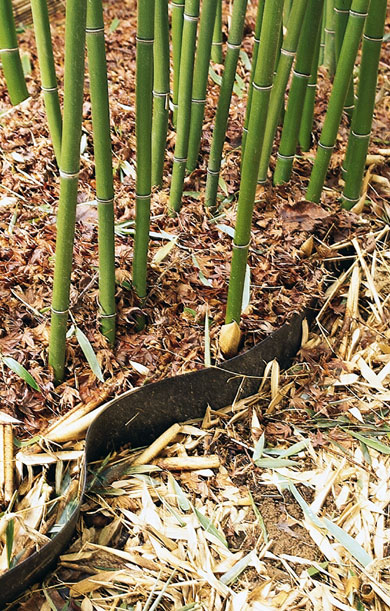
Bamboo can easily get out of control as it grows. Successful containment of bamboo starts before you plant. Although a new planting spreads slowly in its early years, its growth soon speeds up. Put in a barrier -- 40-mil high-density polyethylene -- to a depth of 30 inches around the perimeter of your grove. Equally effective is a concrete barrier, which requires digging a 4- to 6-inch-deep surround trench and filling it with concrete.
To discourage deep rhizome growth, tightly compact the soil in the bottom of the planting hole and amend only the top 6-10 inches. Patrol the perimeter of your bamboo regularly in early summer to check for escapees. Check again when rhizome growth ceases, which will vary depending on where you live. At this stage, any new growth outside the barriers is relatively soft and hasn't yet rooted to the ground, so it's easy to remove.
continue reading below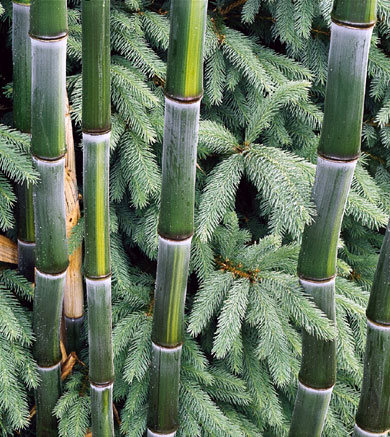 Spring growth on a blue Coloradospruce creates a dramatic backdropfor culms of bamboo.
Spring growth on a blue Coloradospruce creates a dramatic backdropfor culms of bamboo.
Bamboo appreciates plenty of water. Give water to new plantings once a day. The plant thrives in a moderately acidic, loamy soil and responds well to fertilizer high in nitrogen. In addition, bamboo benefits from a 2- to 3-inch mulch of compost, bark, grass clippings, leaves, or hay. Bamboo leaf droppings also act as mulch, nourishing the plant with silica, so you don't need to remove the leaves. Hardy bamboo likes sun but will grow in shade, though it won't get as large. Apply fertilizer just before new growth starts in the spring and then every two to four weeks through summer. After the first year, fertilizer isn't necessary unless you want the plant to spread and send up larger shoots. Left ungroomed, bamboo forms a thicket, frustrating the eye in a blur of intertwined stems and leaves. Each year, use a fine-toothed saw or sharp clippers to prune out selected culms, focusing on the oldest, then removing spindly or crowded ones in an overall thinning. Finally, strip off the lower branches on new growth left standing to expose the beauty of the culms.
Get more bamboo-growing tips.
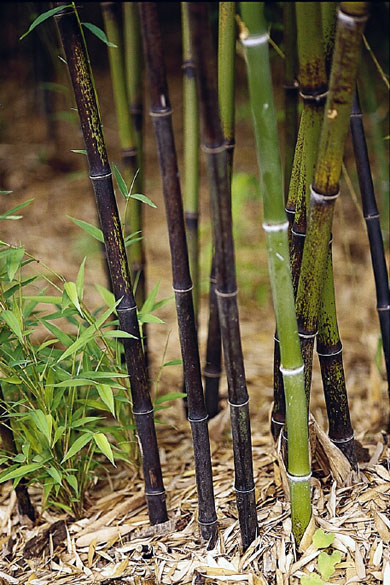 Black Bamboo(Phyllostachys nigra)
Black Bamboo(Phyllostachys nigra)
The versatile nature of bamboo makes it adaptable to almost any size yard. In tight urban settings, Phyllostachys spp. provides a quick-growing screen. For mammoth homes on postage-stamp lots, bamboo helps bring the landscaping into scale, yet doesn't take up a lot of space. It also grows well in tubs as long as it's divided every two years, making it suitable for high-rise balconies or decks. Bamboo canes are rich in variety, too. They sport remarkable colors in solids, stripes, or mottles; they grow upright, zigzag at the lower joints (nodes), or swell like a turtle's back. Some have leaves variegated white or gold. And unlike trees, bamboo can be topped just above a node anywhere along a culm without suffering damage. Shortening culms, as the stalks are called, are handy when you need to preserve a neighbor's view but still want to assure yourself of privacy. Companion plantings can help bamboo blend in with the rest of your garden. Large-leaf underplantings of fuki (Petasites japonicus) and umbrella plant (Darmera peltata), both Zones 5-9, make spectacular companions for lofty bamboo in naturalized settings. So do contrasting forms and leaf shapes, such as those offered by evergreen conifers or Japanese maples (Acer palmatum). For those who must confine bamboo to relatively tight spots, shallow-rooted groundcovers, such as dwarf periwinkle (Vinca minor) and Japanese spurge (Pachysandra terminalis), will scramble about the margins of a grove. Although bamboo grows taller and wider in warmer climates, some bamboo from the Phyllostachys genus will grow in the coldest parts of the United States. The best species for colder sections of the Midwest and all of the Northeast are yellow-groove bamboo (P. aureosulcata), P. nuda, and P. bissetti. During heavy, wet snowfalls, bamboo culms can be weighted to the ground and may even break, though this is rare. Some species are more strongly upright than others, but growth habit varies widely across the country. Your best bet for selecting bamboo that will work for you is to consult an experienced grower, but here are two charts full of good species to consider.
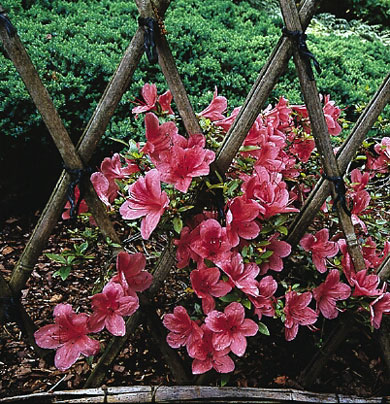
Bamboo is a "value-added" plant; you can build structures from it or even cook with its young, tender shoots. It's great for yard projects because it's a fast-growing, easily renewable source. Although the culms are usually hollow, they're extremely durable; pound for pound, they're stronger than steel. The strongest poles come from three- to five-year-old culms, but you can start using poles the second year. Cut the culms at ground level in early spring, strip them of side growth, and store them flat in a dry, sheltered space for use at a later date. Or, immediately turn them into stakes, hose guides, or standing plant supports and edgings. Bamboo poles can be used to build gates, trellises, panels, and fences. Many nurseries that specialize in bamboo offer classes on building with it and also sell bamboo poles.
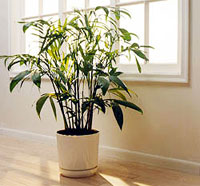 Bamboos need a little TLC, but areeasy once you get the knack forgrowing them.
Bamboos need a little TLC, but areeasy once you get the knack forgrowing them.
More and more, bamboo plants are found indoors. Extremely versatile bamboo plants can be tall and airy, or short and striking. Some can grow in full, direct light others thrive in those darkened corners that the sun rarely sees. In general, bamboos are not to be considered an easy plant to grow indoors.
The use of a pebble tray, which is a tray of rocks that is placed under the plant container, is a good suggestion to help with the challenge of humidity. This tray must contain a small amount of water at all times. As the water evaporates it raises the humidity around your plant. It is important to keep indoor bamboos a little on the dry side, especially during the winter months. This however, by no means suggests that the plant should be allowed to completely dry out. The point is, it is easier to remedy plant stress due to lack of water, rather than trying to remedy plant stress due to overwatering. Overwatering often causes root rot, and once root rot has occurred, the plant can rarely be saved.
Like most interior plants, bamboos require more water in the summer months and less in the "resting" period, or winter months. You can feed your indoor bamboo with a well-rounded fertilizer when the plant is in active growth. You may want to use a fertilizer with trace minerals in it, ensuring the bamboo gets a well balanced diet.
The strong stem cuttings of a dracaena species known as lucky bamboo imitate true bamboo with their exotic, banded form. For this particular design, use any species of dracaena, rooted or unrooted. They make a tropical-looking grove that provides an intriguing centerpiece or room accent. Keep in mind that the design is temporary because dracaenas do not live in water, even though they root in it. Plan to transplant the poles into soil after the stems develop several sets of leaves.
Dracaenas make a perfect plant for people who want an indoor garden but don't have time to devote to a routine of watering and fertilizing. Numerous plants survive neglect, but dracaena thrives on it.
When potted in a 12-inch-diameter or larger container of soil, the dracaena plants need watering only when the soil dries to a depth of about 2 inches. Fertilize every two or three months, but don't worry if you forget. In low light the plants grow more slowly and need less feeding. Dracaenas also adapt to varying amounts of light, from the low light of a northern exposure to the high light of a southern one if set away from the window.
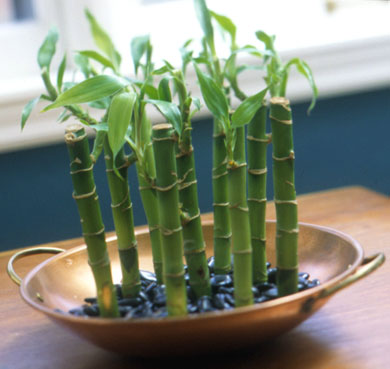 Dracaenas mimic bamboo with
their segmented stems. The
stem cuttings gradually develop
leaves and a more tropical look.
Dracaenas mimic bamboo with
their segmented stems. The
stem cuttings gradually develop
leaves and a more tropical look.
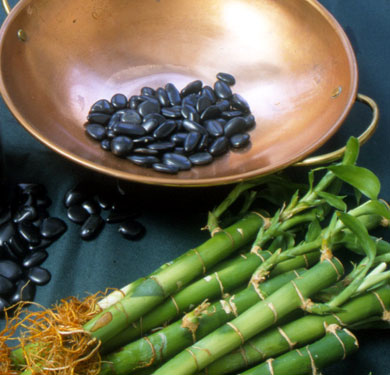
1. Start your grove with rooted or unrooted cuttings. Roots, of course, provide the plants with more immediate stability as they spread out among the stones. On the other hand, the arrangement lasts longer if you start with unrooted cuttings. Once the cuttings have produced many roots and developed three or four sets of leaves, transfer the plans to pots of soil. Dracaenas won't survive in water indefinitely.
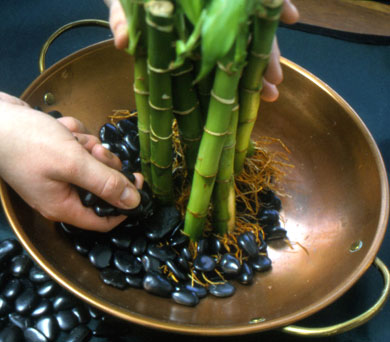
2. Fill the bottom of the wok with a shallow layer of stones, sea glass, or marbles. Set the stems in the wok and hold them firmly as you sprinkle in more stones. Work the roots under and between the stones. Begin to separate and arrange the stems as you add the stones. At this point, however, focus on adding stones and keeping the poles upright. Continue to add stones until the stems feel secure and upright.
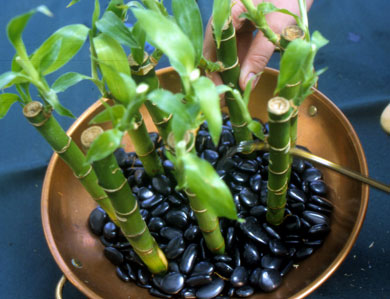
3. Work stems around in the wok, being careful to slide the stems rather than lift them, until the spacing resembles a natural grove, not a clump.
Pour in water to a depth of 1-1/2 to 2 inches. Maintain that depth for the life of the arrangement.
Carefully move the wok to its final location: an end table, dining table, or shelf, for example.
Copyright © www.100flowers.win Botanic Garden All Rights Reserved